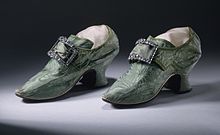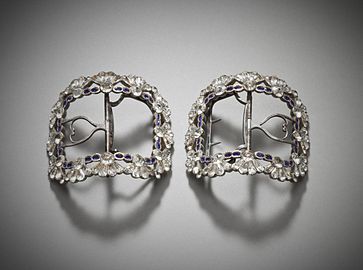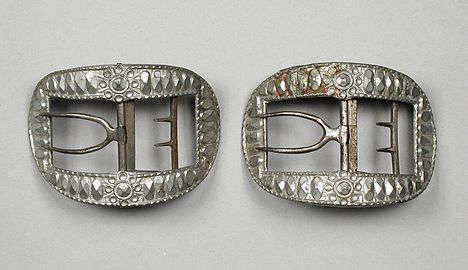Shoe buckle
Appearance

Shoe buckles are
History
Buckled shoes began to replace tied shoes in the mid-17th century:Prince George.[4] While the prince did start to require them for his court, this didn't stop the decline of the shoe buckle.[4] It has been suggested that the decline drove the manufacturers of steel buckles to diversify into producing a range of cut steel jewellery.[4]
Knee buckle
Knee buckles are used to fasten the
knee-high boots
just below the level of the knee.
Gallery
-
Man's steel and gilt wire shoe buckles, England, c. 1777–1785 LACMA M.80.92.6a-b.
-
Woman's silver and steel shoe buckles with paste stones, 1780–85. LACMA M.80.92.1a-b
-
Man's shoe buckles with case. Paste stones with gilded-copper-alloy trim on silver and steel, France, c. 1785. LACMA M.2007.211.829a-b.
-
Man's cut steel shoe buckles, United States, 1780s. LACMA 42.16.23a-b.
See also
- One, Two, Buckle My Shoe
- 1700–1750 in fashion
- 1750–1775 in fashion
- 1775–1795 in fashion
Notes
- ^ Takeda and Spilker (2010), p. 183
- ^ Tortora and Eubank (1995), p. 190
- ^ "The Diary of Samuel Pepys". Retrieved 16 April 2011.
- ^ ISBN 9780239000699.
- ^ Tortora and Eubank (1995), p. 272
- ^ "Victoria and Albert Museum: Shoe Buckles". Retrieved 20 April 2011.
References
Wikimedia Commons has media related to Shoe buckles.
- Takeda, Sharon Sadako, and Kaye Durland Spilker, Fashioning Fashion: European Dress in Detail, 1700 - 1915, Prestel USA (2010), ISBN 978-3-7913-5062-2
- Tortora, Phyllis G. and Keith Eubank. Survey of Historic Costume. 2nd Edition, 1994. Fairchild Publications. ISBN 1-563-67003-8




